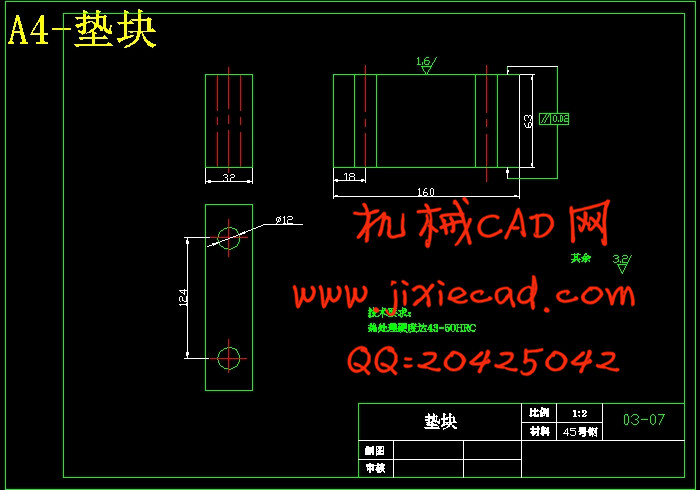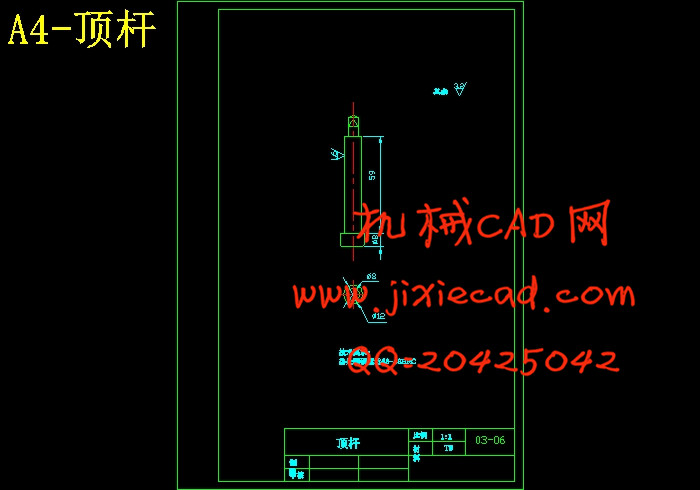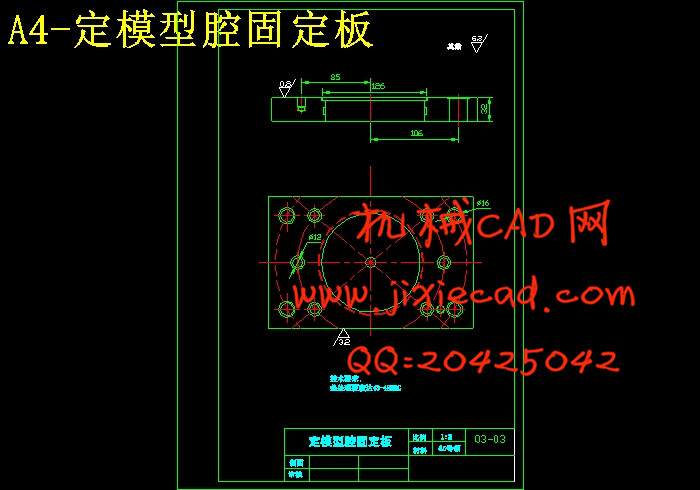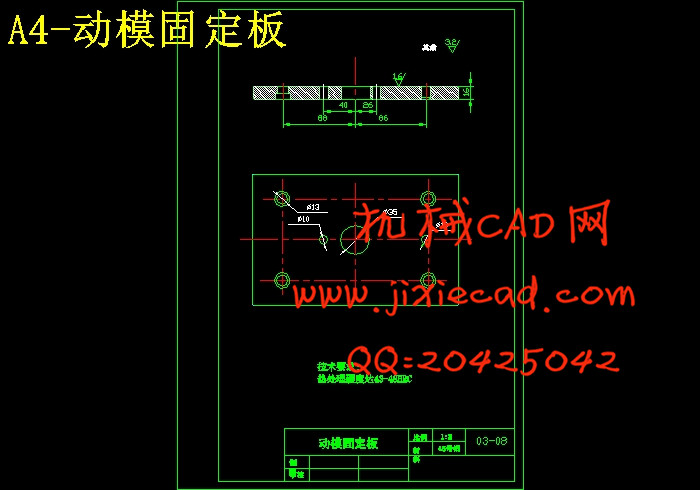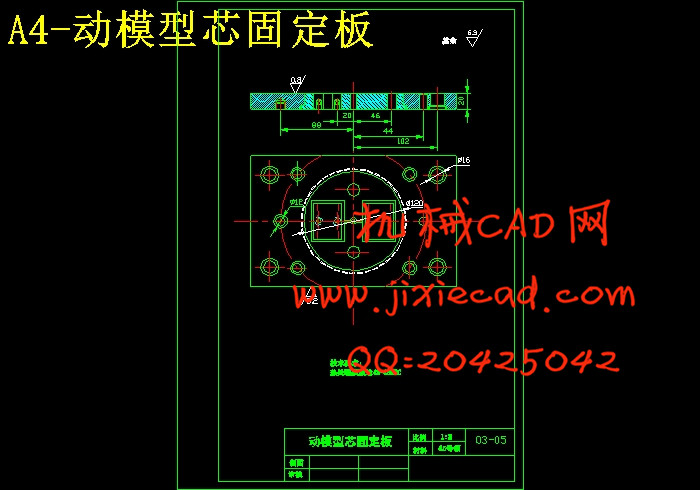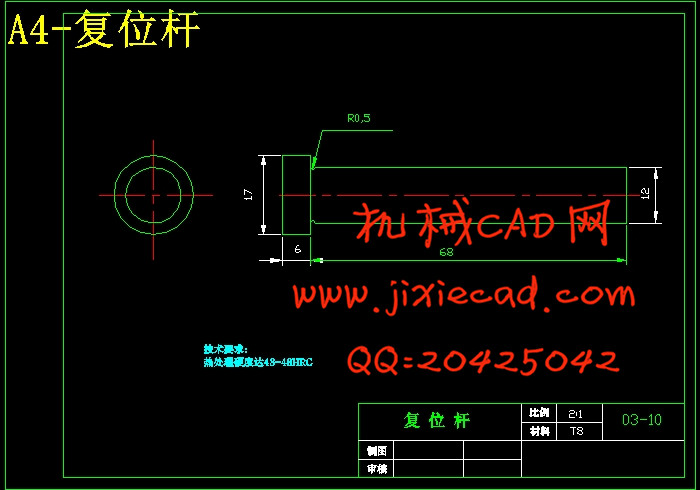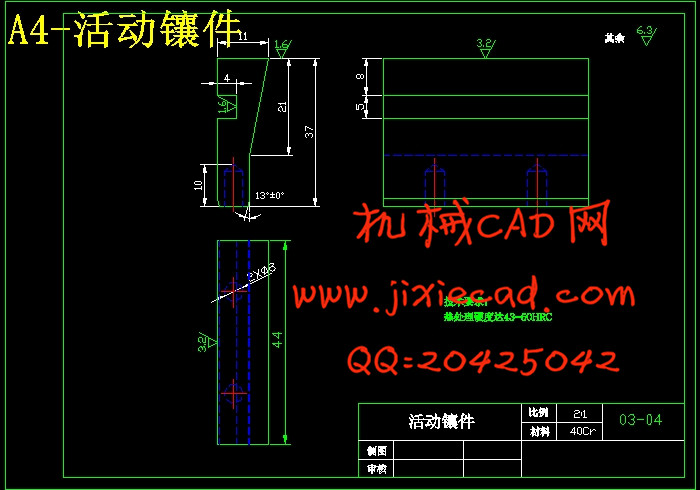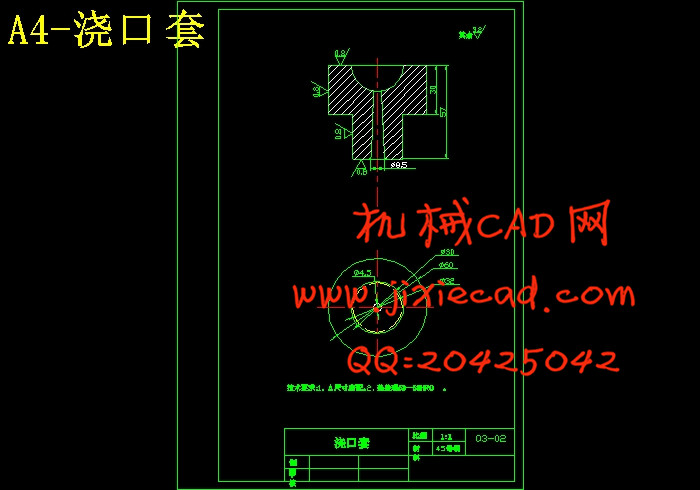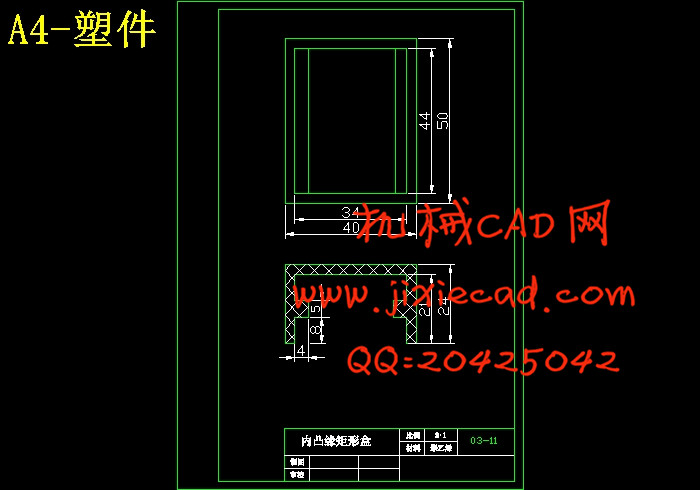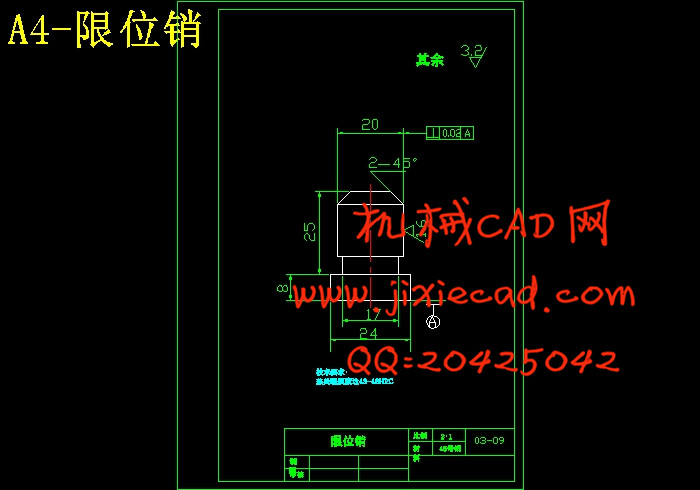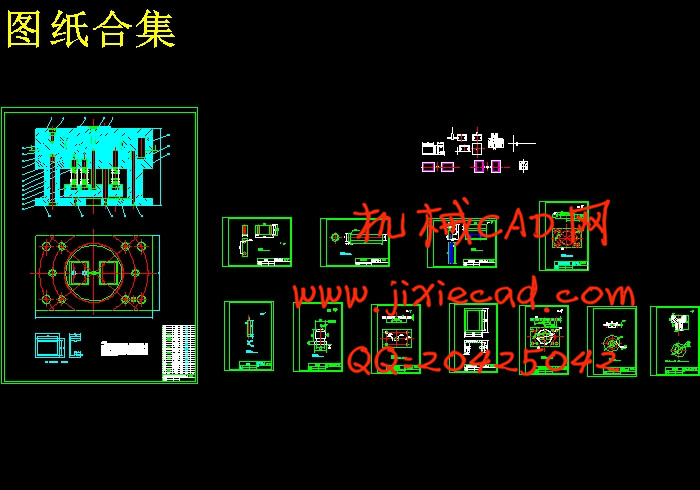设计简介
内凸缘矩形盒
摘要
塑料注射模具是采用注射成形方法生产塑料制品的必备工具,塑料注射模具的制造过程是根据塑料制品零件的形状、尺寸要求,制造出结构合理,使用寿命长、精度较高,成本较低的能批量生产出合格产品的模具制造过程。
在生产塑料注射成形模具时,其模具制造过程应满足以下基本要求:
1.要保证模具质量。
要保证模具质量是指在正常生产条件下,按工艺过程所加工的模具应能达到设计图样所规定的全部精度和表面质量要求,并能够批量生产出合格的产品。模具的质量应该由制造工艺规程所才用的加工方法、加工设备及生产操作人员来保证。
2.要保证模具制造周期。
模具制造周期是指在规定的日期内,将模具制造完毕,模具制造周期的长短,反映了模具生产的技术水平和组织管理水平。在制造模具时,应力求缩短模具制造周期,这就需要制定合理的加工工序,应尽量采用计算机辅助设计(CAD)和计算机辅助制造(CAM)。
3.要保证模具的使用寿命。
模具的使用寿命是指模具在使用过程中的耐用程度,一般以模具生产出的合格制品的数量作为衡量标准。高的使用寿命反映了模具加工制造水平,是模具生产质量的重要指标。
4.要保证模具成本低廉。
模具成本是指模具的制造费用。由于模具是单件生产,机械化、自动化程度不高,所以模具成本较高,为降低模具的制造成本,应根据制品批量大小,合理选择模具材料,制定合理的加工规程,并设法提高劳动生产率。
5.要不断提高加工工艺水平。
模具制造工艺要根据现有条件,尽量采用新工艺、新技术、新材料,以提高模具的生产效率,降低成本,使模具生产有较高的技术经济效益水平。
6.要保证良好的劳动条件。
模具的制造工艺过程要保证操作工人有良好的劳动条件,防止粉尘、噪音、有害气体等污染产生。
内凸缘矩形盒
Abstract
Injection Molding. Injection molding is principally used for the production of thermoplastic parts,although some has been made in dev-
loping a method for injection molding some thermosetting materials.The
problem of injecting a melted plastic into a mold cavity from a reservoir of melted material has been extremely difficule to solve for thermosetting plastics which cure and harden under such conditions within a fec minutes .the principle of injection molding is quite similar to that of die-casting. Plastic powder is loaded into the feed hopper and a certain amount feeds into the heating chamber becomes a fluid. Heating temperatures range from 265 to 500˚F. After the mold is closed, the plunger moves forward, forcing some of the fluid plastic into the mold cavity under pressures ranging from 12000 to30000 psi .Since the mold is cooled by circulating cold-water, the plastic hardens and the part may be ejected when the plunger draws back and the mold opens. Injection-molding machines can be arranged for manual operation,automatic single-cycle operation, and full automatic operation. Typical machines produce molded parts weighing up to 22 ounces at the rate of four shots per minute. The molds used are similar to the dies of a die-casting machine with the exception that the surfaces are chromium-plated.The advantages of injection molding are
1. A high molding speed adapted for mass production is possible .
2. There is a wide choice of thermoplastic materials providing a variety of useful properties.
3. It is possibel to mold threads, undercuts,side holes,and large thin sections.
绪论
第一章 模塑工艺规程的编制
1.1 塑件的工艺性分析
1.1.1 塑件的原材料分析
1.1.2 塑件的结构和尺寸精度及表面质量分析
1.1.2.1结构分析
1.1.2.2尺寸精度分析
1.1.2.3表面质量分析
1.2 计算塑件的体积和质量
1.3 注塑机的选择
1.3.1最大注射量
1.3.2注射压力
1.3.3锁(合)模力
1.4 塑件注塑工艺参数的确定
第二章 注塑模的结构设计
2.1分型面的选择
2.2确定型腔的排列方式
2.3浇注系统的设计
2.3.1主流道设计
2.3.2分流道设计
2.3.3浇口设计
2.4抽芯机构设计
2.4.1确定抽芯距
2.4.2确定斜销倾角
2.4.3确定斜销的尺寸
2.4.4滑块与导滑槽设计
2.4.4.1 滑块与侧型芯(孔)的连接方式设计
2.4.4.2 滑块的导滑方式
2.4.4.3 滑块的的导滑长度和定位装置设计
2.5成型零件结构设计
2.5.1凹模的结构设计
2.5.2凸模的结构设计
第三章 模具设计的有关计算
3.1型腔和型芯工作尺寸计算
3.2型腔侧壁厚度和底板厚度计算
3.2.1下凹模镶块型腔侧壁厚度及底板厚度计算
3.2.1.1 下凹模镶块型腔侧壁厚度计算
3.2.1.2 下凹模镶块底板厚度计算
3.2.2上凹模型腔侧壁厚度计算
第四章 模具加热与冷却系统的计算
第五章 模具闭和高度的确定
第六章 注塑机有关参数的校核
第七章 绘制模具总装图和非标零件工作图
第八章 注塑模主要零件加工工艺规程的编制
设计总结
参考文献
致谢
摘要
塑料注射模具是采用注射成形方法生产塑料制品的必备工具,塑料注射模具的制造过程是根据塑料制品零件的形状、尺寸要求,制造出结构合理,使用寿命长、精度较高,成本较低的能批量生产出合格产品的模具制造过程。
在生产塑料注射成形模具时,其模具制造过程应满足以下基本要求:
1.要保证模具质量。
要保证模具质量是指在正常生产条件下,按工艺过程所加工的模具应能达到设计图样所规定的全部精度和表面质量要求,并能够批量生产出合格的产品。模具的质量应该由制造工艺规程所才用的加工方法、加工设备及生产操作人员来保证。
2.要保证模具制造周期。
模具制造周期是指在规定的日期内,将模具制造完毕,模具制造周期的长短,反映了模具生产的技术水平和组织管理水平。在制造模具时,应力求缩短模具制造周期,这就需要制定合理的加工工序,应尽量采用计算机辅助设计(CAD)和计算机辅助制造(CAM)。
3.要保证模具的使用寿命。
模具的使用寿命是指模具在使用过程中的耐用程度,一般以模具生产出的合格制品的数量作为衡量标准。高的使用寿命反映了模具加工制造水平,是模具生产质量的重要指标。
4.要保证模具成本低廉。
模具成本是指模具的制造费用。由于模具是单件生产,机械化、自动化程度不高,所以模具成本较高,为降低模具的制造成本,应根据制品批量大小,合理选择模具材料,制定合理的加工规程,并设法提高劳动生产率。
5.要不断提高加工工艺水平。
模具制造工艺要根据现有条件,尽量采用新工艺、新技术、新材料,以提高模具的生产效率,降低成本,使模具生产有较高的技术经济效益水平。
6.要保证良好的劳动条件。
模具的制造工艺过程要保证操作工人有良好的劳动条件,防止粉尘、噪音、有害气体等污染产生。
内凸缘矩形盒
Abstract
Injection Molding. Injection molding is principally used for the production of thermoplastic parts,although some has been made in dev-
loping a method for injection molding some thermosetting materials.The
problem of injecting a melted plastic into a mold cavity from a reservoir of melted material has been extremely difficule to solve for thermosetting plastics which cure and harden under such conditions within a fec minutes .the principle of injection molding is quite similar to that of die-casting. Plastic powder is loaded into the feed hopper and a certain amount feeds into the heating chamber becomes a fluid. Heating temperatures range from 265 to 500˚F. After the mold is closed, the plunger moves forward, forcing some of the fluid plastic into the mold cavity under pressures ranging from 12000 to30000 psi .Since the mold is cooled by circulating cold-water, the plastic hardens and the part may be ejected when the plunger draws back and the mold opens. Injection-molding machines can be arranged for manual operation,automatic single-cycle operation, and full automatic operation. Typical machines produce molded parts weighing up to 22 ounces at the rate of four shots per minute. The molds used are similar to the dies of a die-casting machine with the exception that the surfaces are chromium-plated.The advantages of injection molding are
1. A high molding speed adapted for mass production is possible .
2. There is a wide choice of thermoplastic materials providing a variety of useful properties.
3. It is possibel to mold threads, undercuts,side holes,and large thin sections.
绪论
第一章 模塑工艺规程的编制
1.1 塑件的工艺性分析
1.1.1 塑件的原材料分析
1.1.2 塑件的结构和尺寸精度及表面质量分析
1.1.2.1结构分析
1.1.2.2尺寸精度分析
1.1.2.3表面质量分析
1.2 计算塑件的体积和质量
1.3 注塑机的选择
1.3.1最大注射量
1.3.2注射压力
1.3.3锁(合)模力
1.4 塑件注塑工艺参数的确定
第二章 注塑模的结构设计
2.1分型面的选择
2.2确定型腔的排列方式
2.3浇注系统的设计
2.3.1主流道设计
2.3.2分流道设计
2.3.3浇口设计
2.4抽芯机构设计
2.4.1确定抽芯距
2.4.2确定斜销倾角
2.4.3确定斜销的尺寸
2.4.4滑块与导滑槽设计
2.4.4.1 滑块与侧型芯(孔)的连接方式设计
2.4.4.2 滑块的导滑方式
2.4.4.3 滑块的的导滑长度和定位装置设计
2.5成型零件结构设计
2.5.1凹模的结构设计
2.5.2凸模的结构设计
第三章 模具设计的有关计算
3.1型腔和型芯工作尺寸计算
3.2型腔侧壁厚度和底板厚度计算
3.2.1下凹模镶块型腔侧壁厚度及底板厚度计算
3.2.1.1 下凹模镶块型腔侧壁厚度计算
3.2.1.2 下凹模镶块底板厚度计算
3.2.2上凹模型腔侧壁厚度计算
第四章 模具加热与冷却系统的计算
第五章 模具闭和高度的确定
第六章 注塑机有关参数的校核
第七章 绘制模具总装图和非标零件工作图
第八章 注塑模主要零件加工工艺规程的编制
设计总结
参考文献
致谢



